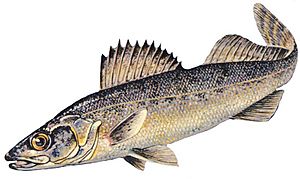Blue walleye facts for kids
Quick facts for kids Sander vitreus glaucus |
|
|---|---|
 |
|
| Scientific classification |
|
| Kingdom: | Animalia |
| Phylum: | Chordata |
| Class: | Actinopterygii |
| Order: | Perciformes |
| Family: | Percidae |
| Genus: | Sander |
| Species: | |
| Subspecies: |
S. v. glaucus
|
| Trinomial name | |
| Sander vitreus glaucus (Hubbs, 1926)
|
|
| Synonyms | |
|
|
The blue walleye (Sander vitreus vitreus), also known as the blue pike, was a special kind of walleye fish. It had a unique blue color! This fish used to live only in the Great Lakes of North America.
For a while, scientists thought the blue walleye was a separate species or a special type (called a subspecies) of walleye. In 1926, they even classified it as its own species. Later, it was considered a subspecies. Sadly, the blue walleye was listed as an endangered species in the United States in 1967. By 1983, it was declared extinct, meaning it had completely disappeared.
However, recent studies using DNA have shown something surprising. Scientists found that the blue walleye was not actually different from the regular yellow walleye (Sander vitreus). This means the blue walleye was just a special color variation of the same species.
What Did the Blue Walleye Look Like?
The blue walleye, or "blue pike," lived in parts of Lake Erie and Lake Ontario. It often shared its home with the regular walleye.
The blue walleye had a cool steel-blue color. It also had slightly larger eyes than the regular walleye. These eyes were placed a bit higher on its head, and they were closer together. While it preferred deeper, cooler parts of Lake Erie, it was also seen in shallower, warmer areas alongside the regular walleye.

